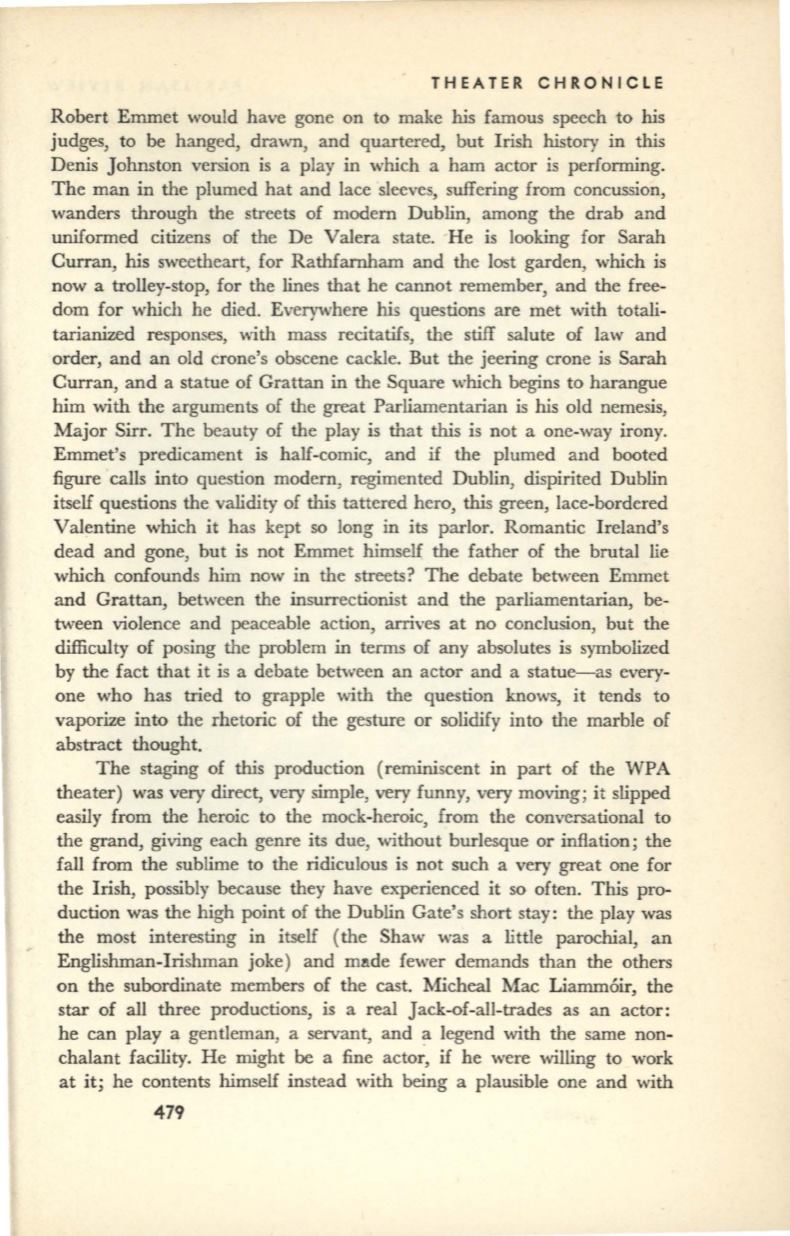
THEATER CHRONICLE
Robert Emmet would have gone on to make his famous speech to his
judges, to be hanged, drawn, and quartered, but Irish history in this
Denis Johnston version is a play in which a ham actor is performing.
The man in the plumed hat and lace sleeves, suffering from concussion,
wanders through the streets of modern Dublin, among the drab and
uniformed citizens of the De Valera state. He is looking for Sarah
Curran, his sweetheart, for Rathfarnham and the lost garden, which is
now a trolley-stop, for the lines that he cannot remember, and the free–
dom for which he died. Everywhere his questions are met with totali–
tarianized responses, with mass recitatifs, the stiff salute of law and
order, and an old crone's obscene cackle. But the jeering crone is Sarah
Curran, and a statue of Grattan in the Square which begins to harangue
him with the arguments of the great Parliamentarian is his old nemesis,
Major Sirr. The beauty of the play is that this is not a one-way irony.
Emmet's predicament is half-comic, and if the plumed and booted
figure calls into question modern, regimented Dublin, dispirited Dublin
itself questions the validity of this tattered hero, this green, lace-bordered
Valentine which it has kept so long in its parlor. Romantic Ireland's
dead and gone, but is not Emmet himself the father of the brutal lie
which confounds him now in the streets? The debate between Emmet
and Grattan, between the insurrectionist and the parliamentarian, be–
tween violence and peaceable action, arrives at no conclusion, but the
difficulty of posing the problem in terms of any absolutes is symbolized
by the fact that it is a debate between an actor and a statue-as every–
one who has tried to grapple with the question knows, it tends to
vaporize into the rhetoric of the gesture or solidify into the marble of
abstract thought.
The staging of this production (reminiscent in part of the WPA
theater) was very direct, very simple, very funny, very moving; it slipped
easily from the heroic to the mock-heroic, from the conversational to
the grand, giving each genre its due, without burlesque or inflation; the
fall from the sublime to the ridiculous is not such a very great one for
the Irish, possibly because they have experienced it so often. This pro–
duction was the high point of the Dublin Gate's short stay: the play was
the most interesting in itself (the Shaw was a little parochial, an
Englishman-Irishman joke) and made fewer demands than the others
on the subordinate members of the cast. Micheal Mac Liamm6ir, the
star of all three productions, is a real Jack-of-all-trades as an actor:
he can play a gentleman, a servant, and a legend with the same non–
chalant facility. He might be a fine actor, if he were willing to work
at it; he contents himself instead with being a plausible one and with
479


